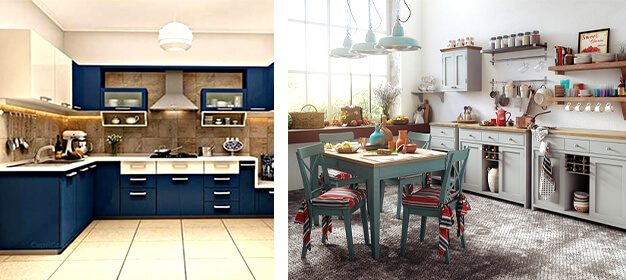The modular kitchen is a fairly new kitchen construction idea in India. But in its short history of two decades, it has gone through many changes to adapt to the requirements of an Indian home. The changes have been so beneficial that we can prove that it is more hygienic, durable, and ergonomically comfortable to opt for a modular kitchen versus a traditional kitchen.
Talking about traditional kitchen it is generally a structure whose base platform, partitions, and shelves are made of concrete or stone. The wall boxes are either non-existent, open concrete or stone shelves, or painted hand-cut boxes. The inside of the platform and counter-top are painted with normal paints which in the end causes dampness to seep through. Since the borders of the platform are uneven the shutters installed on them are uneven as well. This creates cracks, crevices, and spaces for cockroaches and termite infestations.
Further, the drawback of the traditional kitchen is that latest fittings cannot be installed on the stone surface. Telescopic channels were installed in the traditional kitchens. Strips of wood were drilled into the stone partitions so that the channels could be screwed onto them. The movement of these telescopic channels are not smooth and can be damaged easily. To top it off the hinges used cannot be soft close and it is very tough to install drawer systems as well as corner solutions in such kitchens. As for the water area, it is made in a similar way and hence might be durable but very hard to clean and untidy.
Now let’s come to a modular kitchen. It is defined as a kitchen made up of individual wooden boxes that are installed on legs and use hinges and other innovative hardware to make storage and cooking convenient. Instead of sitting on the uneven stone partition, the modules stand on legs. This makes sure that they are four inches off the floor. This provides an extra layer of protection to the boxes from water and dust. The individual boxes are made of wooden material that has a thickness of 16 to 18mm. This ensures that more space can be used for storage and less wasted in the form of partitions. These boxes are pressed with food-grade laminates and hence are more hygienic than paints.
These modules are cut and pressed on machinery because of which there are no gaps between the shutter and the boxes. Further more innovative fittings like pull outs, pull downs and hydraulic fittings make the cooking space organised and easier to function in. Quality kitchen hardware have good load bearing capacities and even better durability. It is possible to make complete use of the box space where earlier it would have been hard to access the back side of any cabinet. Pull downs make it possible to access the top shelf of the cabinetry. The corners which are mostly dead spaces can be accessed with fittings like S-Crousel and others. The boxes of the modular kitchen are made in a way that only 10% of the entire box actually touches the wall. This makes it very difficult for it to be effected by any type of moisture or termite.
Hence through the article we have proven that structurally the modular kitchen format is more hygienic and resistant towards moisture and termite. It is easier to work in this kind of kitchen because the appliances and food materials are stored in a more organised and accessible way. Last but not the least it actually provides more storage than a traditional kitchen.

